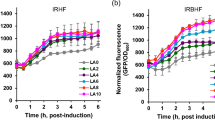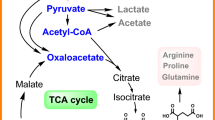Abstract
NAD kinase was overexpressed to enhance the accumulation of poly(3-hydroxybutyrate) (PHB) in recombinant Escherichia coli harboring PHB synthesis pathway via an accelerated supply of NADPH, which is one of the most crucial factors influencing PHB production. A high copy number expression plasmid pE76 led to a stronger NAD kinase activity than that brought about by the low copy number plasmid pELRY. Overexpressing NAD kinase in recombinant E. coli was found not to have a negative effect on cell growth in the absence of PHB synthesis. Shake flask experiments demonstrated that excess NAD kinase in E. coli harboring the PHB synthesis operon could increase the accumulation of PHB to 16–35 wt.% compared with the controls; meanwhile, NADP concentration was enhanced threefold to sixfold. Although the two NAD kinase overexpression recombinants exhibited large disparity on NAD kinase activity, their influence on cell growth and PHB accumulation was not proportional. Under the same growth conditions without process optimization, the NAD kinase-overexpressing recombinant produced 14 g/L PHB compared with 7 g/L produced by the control in a 28-h fermentor study. In addition, substrate to PHB yield Y PHB/glucose showed an increase from 0.08 g PHB/g glucose for the control to 0.15 g PHB/g glucose for the NAD kinase-overexpressing strain, a 76% increase for the Y PHB/glucose. These results clearly showed that the overexpression of NAD kinase could be used to enhance the PHB synthesis.



Similar content being viewed by others
References
Ahn WS, Park SJ, Lee SY (2000) Production of poly(3-hydroxybutyrate) by fed-batch culture of recombinant Escherichia coli with a highly concentrated whey solution. Appl Environ Microbiol 66:3624–3627
Anderson AJ, Dawes EA (1990) Occurrence, metabolism, metabolic role, and industrial uses of bacterial polyhydroxyalkanoates. Microbiol Rev 54:450–472
Chen GQ, Wu Q (2005) The application of polyhydroxyalkanoates as tissue engineering materials. Biomaterials 26:6565–6578
Garavaglia S, Galizzi A, Rizzi M (2003) Allosteric regulation of Bacillus subtilis NAD kinase by quinolinic acid. J Bacteriol 185:4844–4850
Grose JH, Joss L, Velick SF, Roth JR (2006) Evidence that feedback inhibition of NAD kinase controls responses to oxidative stress. Proc Natl Acad Sci U S A 103:7601–7606
Jung YM, Lee JN, Shin HD, Lee YH (2004) Role of tktA gene in pentose phosphate pathway on odd-ball biosynthesis of poly-beta-hydroxybutyrate in transformant Escherichia coli harboring phbCAB operon. J Biosci Bioeng 98:224–227
Kabir MM, Shimizu K (2003) Fermentation characteristics and protein expression patterns in a recombinant Escherichia coli mutant lacking phosphoglucose isomerase for poly(3-hydroxybutyrate) production. Appl Microbiol Biotechnol 62:244–255
Kang Z, Wang Q, Zhang HJ, Qi QS (2008) Construction of a stress-induced system in Escherichia coli for efficient polyhydroxyalkanoates production. Appl Microbiol Biotechnol 79:203–208
Kawai S, Mori S, Mukai T, Hashimoto W, Murata K (2001a) Molecular characterization of Escherichia coli NAD kinase. Eur J Biochem 268:4359–4365
Kawai S, Suzuki S, Mori S, Murata K (2001b) Molecular cloning and identification of UTR1 of a yeast Saccharomyces cerevisiae as a gene encoding an NAD kinase. FEMS Microbiol Lett 200:181–184
Kovach ME, Elzer PH, Hill DS, Robertson GT, Farris MA, Roop RMII, Peterson KM (1995) Four new derivatives of the broad-host-range cloning vector pBBR1MCS, carrying different antibiotic-resistance cassettes. Gene 166:175–176
Lai WJ, Chen GQ (2006) Polyhydroxybutyrate synthesis in recombinant Zymomonas mobilis affected ethanol production. China Biotechnology 26:52–56
Lee SY (1997) E. coli moves into the plastic age. Nat Biotechnol 15:17–18
Lee SY, Lee YK, Chang HN (1995) Stimulatory effects of amino-acids and oleic-acid on poly(3-hydroxybutyric acid) synthesis by recombinant Escherichia coli. J Ferment Bioeng 79:177–180
Lee IY, Kim MK, Park YH, Lee SY (1996) Regulatory effects of cellular nicotinamide nucleotides and enzyme activities on poly(3-hydroxybutyrate) synthesis in recombinant Escherichia coli. Biotechnol Bioeng 52:707–712
Lee SY, Choi JI, Wong HH (1999) Recent advances in polyhydroxyalkanoate production by bacterial fermentation: mini-review. Int J Biol Macromol 25:31–36
Lemoigne M (1926) Products of dehydration and of polymerization of β-hydroxybutyric acid. Bull Soc Chim Biol 8:770–782
Lenz RW, Marchessault RH (2005) Bacterial polyesters: biosynthesis, biodegradable plastics and biotechnology. Biomacromolecules 6:1–8
Lerner F, Niere M, Ludwig A, Ziegler M (2001) Structural and functional characterization of human NAD kinase. Biochem Biophys Res Commun 288:69–74
Lim SJ, Jung YM, Shin HD, Lee YH (2002) Amplification of the NADPH-related genes zwf and gnd for the oddball biosynthesis of PHB in an E. coli transformant harboring a cloned phbCAB operon. J Biosci Bioeng 93:543–549
Liu Q, Ouyang SP, Chung A, Wu Q, Chen GQ (2007) Microbial production of R-3-hydroxybutyric acid by recombinant E. coli harboring genes of phbA, phbB, and tesB. Appl Microbiol Biotechnol 76:811–818
Magni G, Orsomando G, Raffaelli N (2006) Structural and functional properties of NAD kinase, a key enzyme in NADP biosynthesis. Mini Rev Med Chem 6:739–746
Ochiai A, Mori S, Kawai S, Murata K (2004) Overexpression, purification, and characterization of ATP-NAD kinase of Sphingomonas sp A1. Protein Expr Purif 36:124–130
Peoples OP, Sinskey AJ (1989) Poly-beta-hydroxybutyrate (PHB) biosynthesis in Alcaligenes eutrophus H16. Identification and characterization of the PHB polymerase gene (phbC). J Biol Chem 264:15298–15303
Sanchez AM, Andrews J, Hussein I, Bennett GN, San KY (2006) Effect of overexpression of a soluble pyridine nucleotide transhydrogenase (UdhA) on the production of poly(3-hydroxybutyrate) in Escherichia coli. Biotechnol Prog 22:420–425
Sauer U, Canonaco F, Heri S, Perrenoud A, Fischer E (2004) The soluble and membrane-bound transhydrogenases UdhA and PntAB have divergent functions in NADPH metabolism of Escherichia coli. J Biol Chem 279:6613–6619
Schubert P, Steinbüchel A, Schlegel HG (1988) Cloning of the Alcaligenes eutrophus genes for synthesis of poly-beta-hydroxybutyric acid (PHB) and synthesis of PHB in Escherichia coli. J Bacteriol 170:5837–5847
Shi HD, Nikawa J, Shimizu K (1999) Effect of modifying metabolic network on poly-3-hydroxybutyrate biosynthesis in recombinant Escherichia coli. J Biosci Bioeng 87:666–677
Slater SC, Voige WH, Dennis DE (1988) Cloning and expression in Escherichia coli of the Alcaligenes eutrophus H16 poly-beta-hydroxybutyrate biosynthetic pathway. J Bacteriol 170:4431–4436
Song BG, Kim TK, Jung YM, Lee YH (2006) Modulation of talA gene in pentose phosphate pathway for overproduction of poly-beta-hydroxybutyrate in transformant Escherichia coli harboring phbCAB operon. J Biosci Bioeng 102:237–240
Spiekermann P, Rehm BH, Kalscheuer R, Baumeister D, Steinbüchel A (1999) A sensitive, viable-colony staining method using Nile red for direct screening of bacteria that accumulate polyhydroxyalkanoic acids and other lipid storage compounds. Arch Microbiol 171:73–80
Steinbüchel A, Valentin HE (1995) Diversity of bacterial polyhydroxyalkanoic acids. FEMS Microbiol Lett 128:219–228
Steinbüchel A, Lutke-Eversloh T (2003) Metabolic engineering and pathway construction for biotechnological production of relevant polyhydroxyalkanoates in microorganisms. Biochem Eng J 16:81–96
Wei XX, Shi ZY, Yuan MQ, Chen GQ (2009) Effect of anaerobic promoters on the microaerobic production of polyhydroxybutyrate (PHB) in recombinant Escherichia coli. Appl Microbiol Biotechnol. doi:https://doi.org/10.1007/s00253-008-1816-4
Yanisch-Perron C, Vieira J, Messing J (1985) Improved M13 phage cloning vectors and host strains: nucleotide sequences of the M13mp18 and pUC19 vectors. Gene 33:103–119
Zerez CR, Lee SJ, Tanaka KR (1987) Spectrophotometric determination of oxidized and reduced pyridine nucleotides in erythrocytes using a single extraction procedure. Anal Biochem 164:367–73
Zheng Z, Li M, Xue XJ, Tian HL, Li Z, Chen GQ (2006) Mutation on N-terminus of polyhydroxybutyrate synthase of Ralstonia eutropha enhanced PHB accumulation. Appl Microbiol Biotechnol 72:896–905
Acknowledgements
We are grateful to Prof. Alexander Steinbüchel of the University of Münster in Germany for the generous donation of plasmid pBHR68. The research was supported by the China National High Tech 863 Grants (Project Nos. 2006AA02Z242 and 2006AA020104), as well as the State Basic Science Foundation 973 (2007CB707804).
Author information
Authors and Affiliations
Corresponding authors
Rights and permissions
About this article
Cite this article
Li, ZJ., Cai, L., Wu, Q. et al. Overexpression of NAD kinase in recombinant Escherichia coli harboring the phbCAB operon improves poly(3-hydroxybutyrate) production. Appl Microbiol Biotechnol 83, 939–947 (2009). https://doi.org/10.1007/s00253-009-1943-6
Received:
Revised:
Accepted:
Published:
Issue Date:
DOI: https://doi.org/10.1007/s00253-009-1943-6




